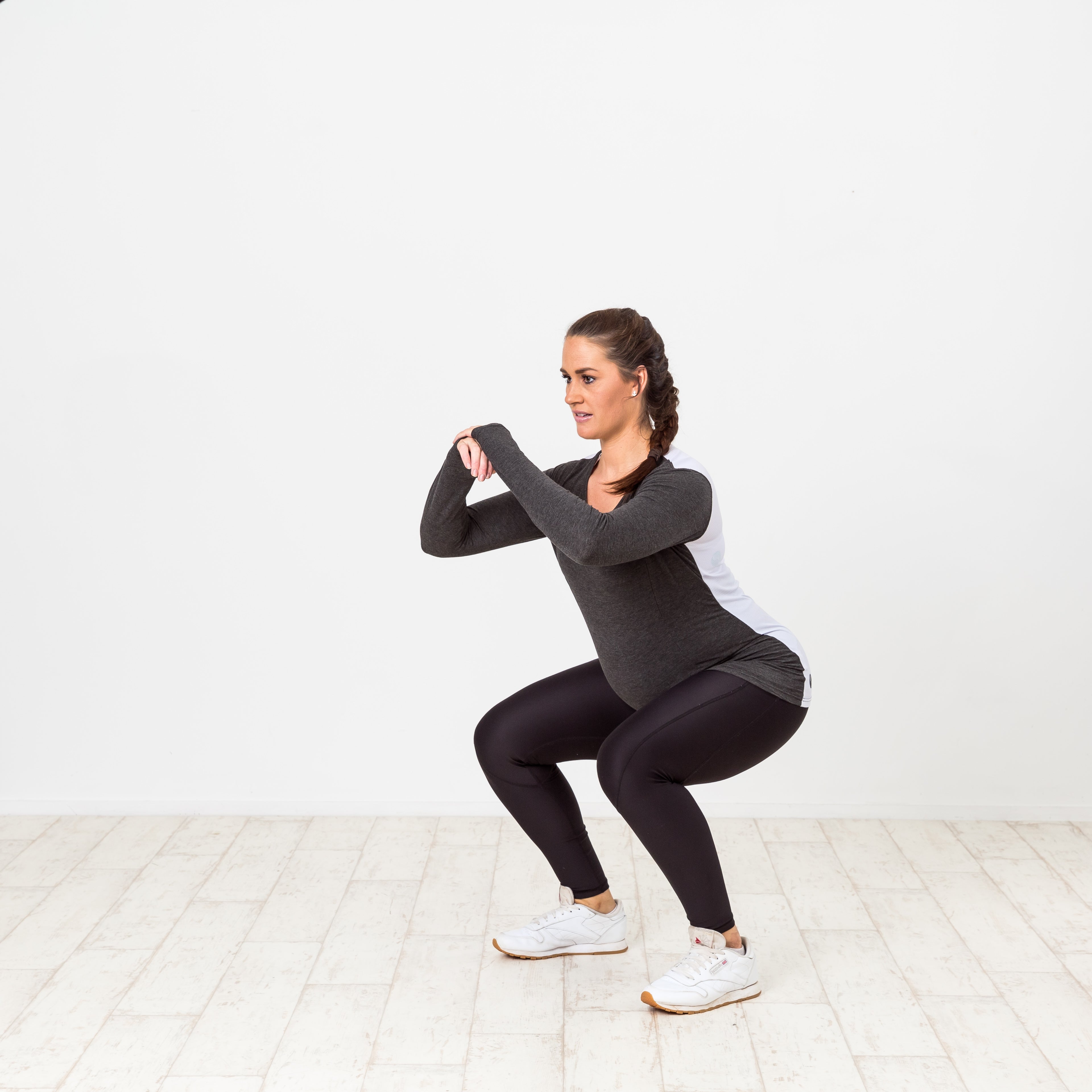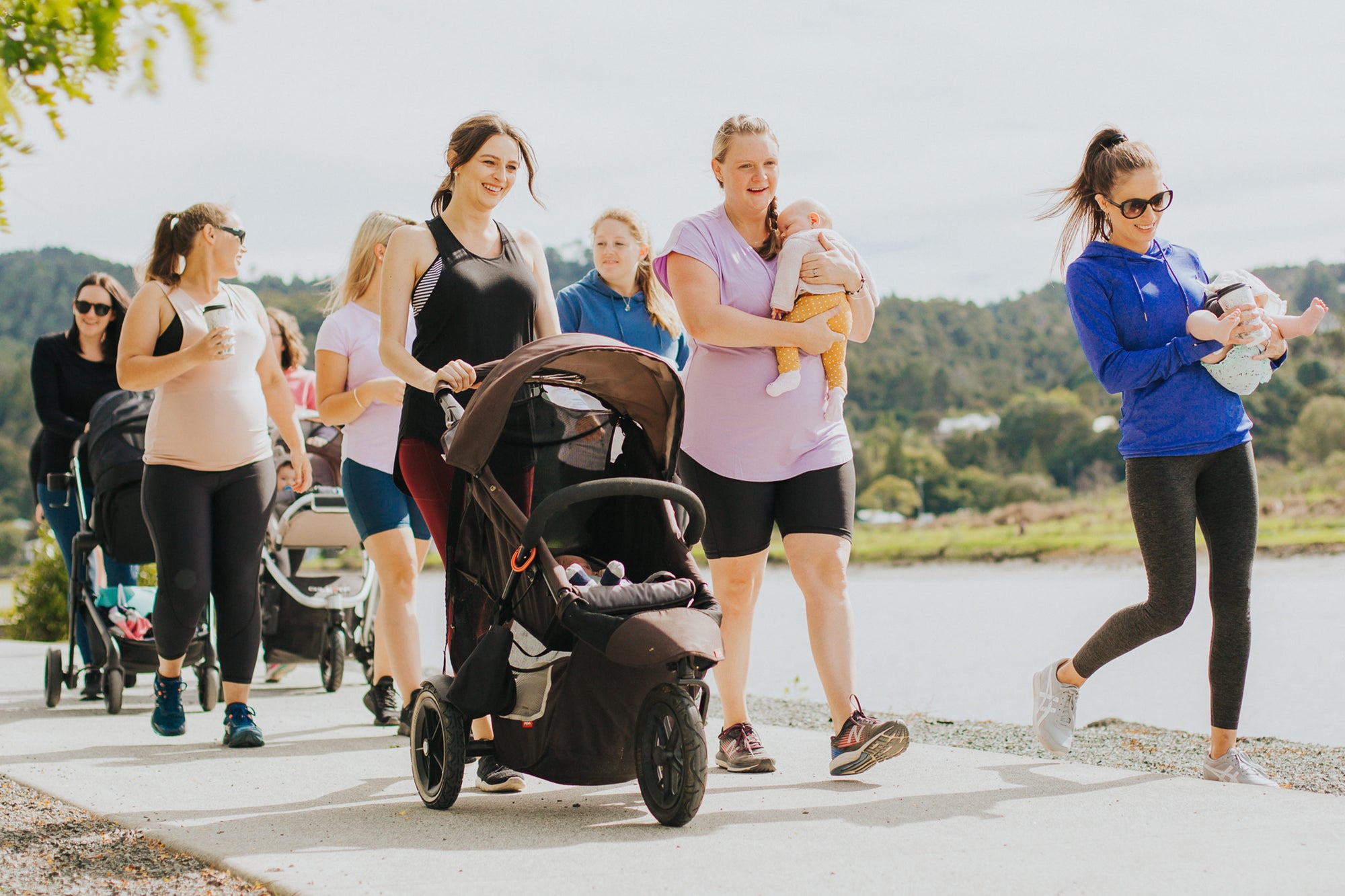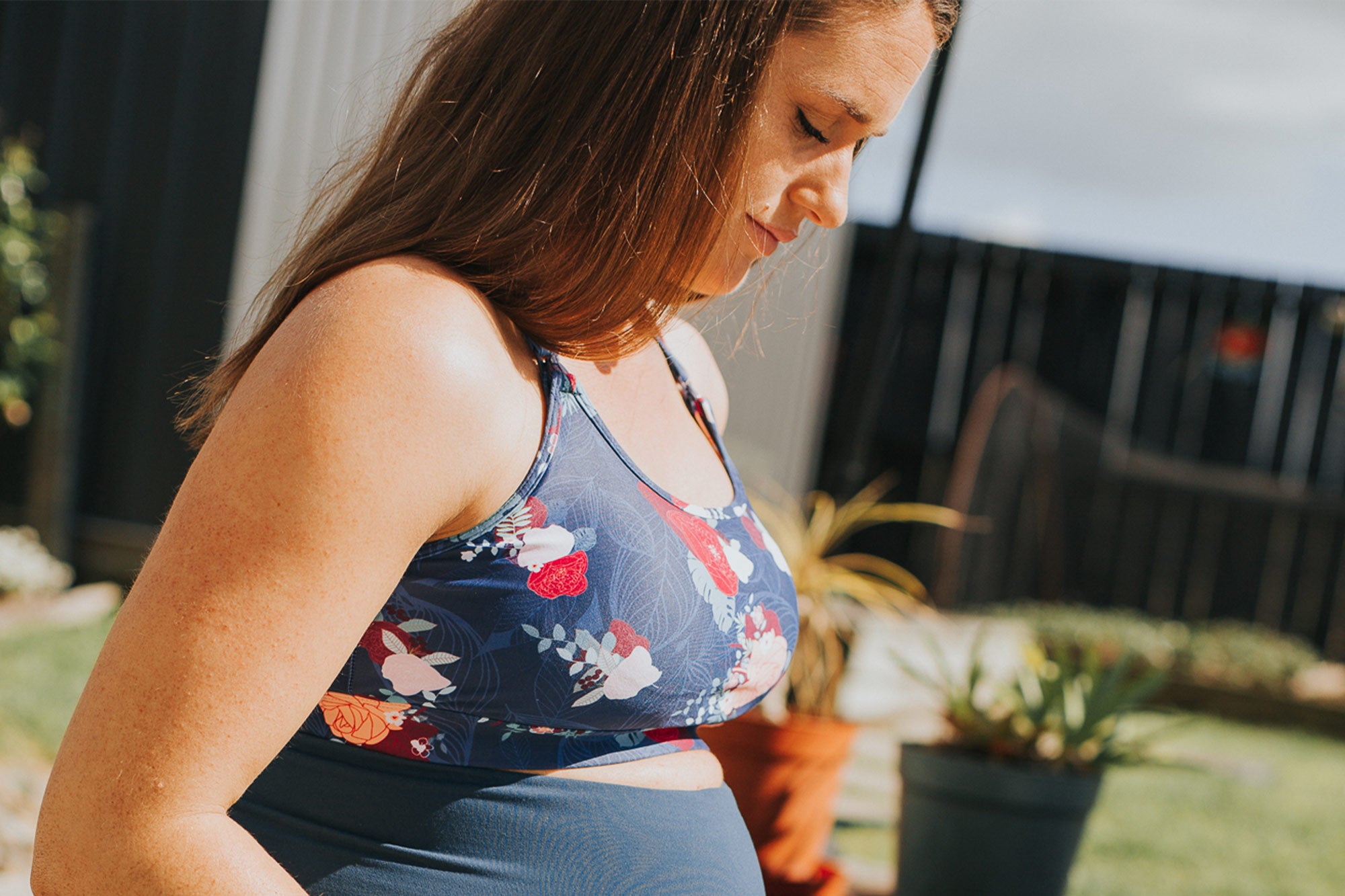Alysia is wearing the 'Swift Bra' in stellar, the 'Casual Tank' in navy, and the 'High Waisted Running Shorts.'
I’m no professional athlete, but I do like to workout regularly, so, when I first fell pregnant, I thought about my exercise regime and how it would affect me and my growing baby. Should I really be doing clean and jerks, snatches, burpees, squat jumps etc. with a little human in my belly?
Naturally, I turned to ‘Google’ for some answers. I learnt a few things, but mainly I was left a tad confused and not entirely sure on what I should/shouldn’t be doing. In the end I didn’t end up doing much at all and gained a few too many kgs, not to mention became incredibly unfit...which I hated.
My husband and I are going to try for a third baby soon (woohoo!), and if we are blessed once more, I really want to keep my fitness up this time. So instead of being ignorant around pregnancy and exercise, I decided to learn more on the topic - not only for myself, but for the whole Cadenshae community...who all want to exercise when pregnant, safely.
What’s okay, and what isn’t? Should you scale back, or charge on as before? Can you still lift weights? Will you do yourself, or your baby any harm? So many questions...so I enlisted some trained and qualified professionals to answer them for me (and you!), those who have been working in this arena for years and need to be ‘in the know’ for their clientele.
Cue Lorraine Scarpens and Joanna Perkins.
Lorraine is the creator of 'The Fit Mum Programs,’ and a personal trainer who has worked with thousands of pregnant women for over 25 years to keep them fit, healthy, strong...and safe. Joanna Perkins is a specialist Women’s Health Physiotherapist and founder of ‘The Glow Method at Home’ and ‘Mumma Physio.’
Here’s what these two had to say:
- Can a woman exercise when pregnant?
Lorraine:
Absolutely! Pregnant women should exercise for all the benefits to both them and their baby. The only time women should avoid exercise is when they are medically recommended not to, or too sick (hyperemesis gravidarum).
Joanna:
Yes, absolutely. There’s no evidence suggesting a link between moderate exercise and miscarriage or pre-term birth. Unless a woman has specific health or pregnancy risk factors and her health care provider has advised her not to exercise (i.e. multiple miscarriages, placenta previa, carrying more than one baby, high or low blood pressure, unstable cardiac or respiratory issues, unstable diabetes etc.) then exercise is not only safe, but extremely beneficial for both the mother’s and baby’s health. Exercise can reduce the chances of gestational diabetes and hypertension by up to 40%, decrease the likelihood of preeclampsia and incontinence, as well as ensure a more positive pregnancy, labour and postnatal recovery.
Exercise can also relieve stress which ultimately can minimize the chances of miscarriage, as opposed to doing nothing, if a woman is feeling particularly stressed.
Summary: Unless she’s been advised not to, a pregnant woman can and should exercise (safely), for the benefit of her and her baby.
 Joanna and Betsan are wearing the 'Smoothie Crop Bra' in white and the 'Classic Maternity Leggings.'
Joanna and Betsan are wearing the 'Smoothie Crop Bra' in white and the 'Classic Maternity Leggings.'
- What about women who workout regularly? Can she keep going as normal, or does she have to scale back now she’s pregnant?
Lorraine:
Often by dropping the training volume to around 70-80% MHR (maximum heart rate), with some short intervals at 85-90% MHR; most women can continue to workout daily, doing what they usually do. A rule of thumb is not to increase pregnancy tiredness and fatigue, so for each hour of exercise a woman does, she should also rest the equivalent, i.e. sleep for an hour if you workout for an hour.
Joanna:
If you’re used to exercising then there’s no reason you can’t continue unless you’ve been advised otherwise and/or have specific risk factors. The main things to avoid are contact sports (boxing, rugby, basketball etc.) and exercising in hot and humid environments. Depending on your normal activity level you may need to tone down the intensity and adapt certain aspects of your training to ensure you’re not working to absolute fatigue, getting dehydrated, overheating or burning too many calories.
Summary: If a woman works out regularly, she can keep going, but should scale back to 70-80% MHR with a few short intervals at 85-90% MHR. It’s very important she keeps cool (running outside on a hot/humid day is a bad idea), hydrated, adequately fed and rested. When pregnant, it’s highly recommended a woman exercises, but she shouldn’t be ‘training’ for anything. Also, she should avoid any sports that could cause trauma to her belly, and thus her baby.
- What about those who don’t usually exercise - what can they do when pregnant?
Joanna:
If you’re not used to exercising then some experts recommend you wait until your 12 week scan before doing some low to moderate intensity exercise, just to be on the safe side (gentle walking for 20m is fine though). It’s a good idea to liaise with your healthcare provider if you’ve not exercised much leading up to the pregnancy for specific advice pertaining to you. If all is well, gradually increase the time and intensity of your exercise, building slowly up to the recommended prescription of 150 minutes per week (around 20 minutes a day).
Lorraine:
For mums who have been sick during their pregnancy or are not sure how to workout, I often suggest gentle walking for 20m, 3-4 times a week and then include 3-5 functional exercises like squats and hip bridges if they choose. Functional exercises will improve pregnancy core strength and function and can help prevent lower back and pelvic pain.
Summary: Gentle walking at any time during pregnancy is generally fine. Some experts recommend women who haven’t exercised much wait until 12 weeks to begin more intensive movement. If a pregnant woman is having no issues and wants to add some functional exercises to her workout (at any time), this would be extremely beneficial for her core strength and help prevent lower back and pelvic pain. Around 20 minutes of movement a day (150 minutes a week) is recommended.
 Nikki J is wearing the 'Classic Maternity Leggings - Full Length.'
Nikki J is wearing the 'Classic Maternity Leggings - Full Length.'
 Nikki C is wearing the 'Casual Tank' in grey and the 'Classic Maternity Leggings.'
Nikki C is wearing the 'Casual Tank' in grey and the 'Classic Maternity Leggings.'
- Is there any danger to a fetus/baby when the mother is exercising?
Lorraine:
Latest studies suggest that continuously exercising above 90% MHR may increase fetal stress and reduce blood flow to the baby. However, due to limited studies on exercise intensity whilst pregnant, I suggest (as stated previously) women do a few short intervals at 85-90% (while the rest of the workout hovers at around 70-80%), especially for those who are advanced exercisers.
Joanna:
The body is pretty incredible at looking after the baby, and as long as you’re sensible and listen to the recommended advice, then the baby will be safe. If you’re working out and collapsing for example, this could be dangerous. Ensuring you’re well hydrated, not overheating and consuming enough calories will mean the baby is happy too. Also again, avoid contact sports or anything where you could fall easily.
Summary: No, not if she’s sticking to the recommended guidelines and avoiding contact sports or things that increase her likelihood of falling.
- Is there any danger to a pregnant woman while exercising?
Joanna:
During pregnancy there’s an increase in levels of the hormone ‘relaxin,’ which increases ligament laxity. Therefore, a woman’s body is more reliant than ever on muscular support. If there isn’t adequate muscular support or if a woman demands more of her body than the strength available, then injury can occur. Frequently in pregnancy this is lower back pain or sacroiliac joint pain. It’s important to listen to your body, continue with strengthening work with something like light resistance work or pilates, focusing on strengthening the glutes, deep core muscles and pelvic floor. It’s not the time to start lifting new heavy weights if this isn’t something you’re used to or been guided to do. Other risks to a mum-to-be are lack of fluids or calories causing excessive fatigue, nausea or dizziness.
Lorraine:
Exercising frequently at high intensities will cause more pregnancy fatigue and nausea.
Summary: If a woman is not sticking to the recommended guidelines she could experience pregnancy fatigue, dizziness and nausea. She is also at a higher risk of injury due to the relaxin hormone surging through her body. If a woman is not drinking or eating enough this will cause issues for herself and her baby.
- What’s the best type of exercise a woman can do whilst pregnant?
Lorraine:
The best type of exercise for women to do is what they enjoy and then make modifications to suit each stage of pregnancy. I suggest women include core, glute, and posture exercises as the benefits these exercises give are huge! During the last 5-8 weeks of pregnancy, women should also start training specifically for labour.
Joanna:
A mixture of light aerobic and light resistance exercise are recommended in pregnancy. Pilates can be a brilliant way of maintaining core strength in a safe and progressive way. It’s also an important time to start doing pelvic floor exercises too. The recommendations are 10 second holds x 10 repetitions, followed by 10 quick contractions on/off. Repeat this three times daily. Using the ‘talk test’ (still being able to talk in sentences) is a good way to monitor intensity.
Summary: Whatever she enjoys doing (at a lower intensity to normal), but anything that includes core, glutes, pelvic and posture work is great too. Pilates is ideal.
- Can a pregnant woman lift weights?
Joanna:
The main risk to heavy lifting is to the mother rather than the baby. It’s a case of being sensible, using good techniques to avoid injury and managing what we call your ‘intra abdominal pressure.’ If there’s excessive straining a woman may notice abdominal doming, incontinence or pain. If that’s the case, she may need to lower the weight, or modify the lift as a starting point.
Lorraine:
With heavy weight lifting there have been very few studies conducted. As a guideline though, I recommend women need to maintain proper lifting techniques and control the load with their core muscles. Often women will decrease weights naturally by 15-25% as their pregnancy progresses. What is essential for women to know is that some women may comfortably squat 60kg pre-pregnancy, so squatting 30kg is easy for them. Intensity and volume of exercise vary, it needs to be specific as it depends on an individual's pre-pregnancy fitness and strength.
Summary: You can continue to lift weights if you’re used to it, but you should lower the amount as the relaxin hormone puts a pregnant woman at a higher risk of injury. She must maintain good form and technique, and weight-lifting should only be done by those who’re experienced in it.
 Alysia is wearing the 'Evolve Bra' and the 'Shine Bright Tights.'
Alysia is wearing the 'Evolve Bra' and the 'Shine Bright Tights.'
- Is there anything specific pregnant women should wear when exercising?
Joanna:
Pregnant women need to watch that they don’t overheat, so wearing clothing that is cool and comfortable is key - tank tops are perfect. Supportive bras for growing breasts also make exercise more comfortable. Similarly with supportive leggings, having an over bump option can make you feel more comfy and supported so you feel ready and motivated to exercise.
Lorraine:
Women should ensure they wear comfortable and supportive activewear. Sports bras should be able to support heavy and sore breasts, and exercise tights should also offer support to mum’s growing bump. Wearing a waistband that is too restricted can increase abdominal discomfort, so women need to switch to tights that have both high and low waistband options. Women also need to make sure that they are always at a comfortable temperature; layers are pregnancy perfect!
Summary: Cadenshae has everything you need, full stop!
So there you have it, a solid run down on what a woman should/shouldn’t be doing whilst pregnant!
Personally, I’ve had a few miscarriages, so after learning about all of this, if I fall pregnant again I’d take it very easy for the first 12 weeks (I’m usually too sick to cope anyway!) and then I would continue doing what I usually do, but to a lesser degree. I’d also keep myself cool, drink lots of fluids, rest and of course eat well...but that’s never been a problem for me, pregnant or not! ;) It’s really great to have some direction now, and the confidence I’m doing the right thing by me and my baby.
I’m sure the experts would agree, when you’re pregnant you should continuously listen to your body. If you feel up to it, go for it...if you’re just too tired and need to sleep, sleep. As long as you’re doing some sort of regular exercise, you’re winning. Now’s not the time to punish yourself, it’s the time to nurture yourself, and your growing bubba.
If you’re looking for some pregnancy friendly workouts, check out these ‘Fit Mama Tips’ from the owner/founder of Cadenshae - Nikki Clarke. Nikki is not only a mother of FIVE, but before starting Cadenshae was a highly sought after personal trainer - so she knows her stuff too! Enjoy!
Written by Ellen Chisholm in conjunction with Lorraine Scarpens and Joanna Perkins.



